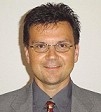 Society
of Exploration Geophysicists Distinguished Lecturer
Society
of Exploration Geophysicists Distinguished LecturerGreg Partyka
with BP
Mark your calenders:
Geological. and Mining
Engineering and Sciences
SEMINAR
4 p.m. Wednesday, Jan. 26, 2005
Room to be announced
 Society
of Exploration Geophysicists Distinguished Lecturer
Society
of Exploration Geophysicists Distinguished Lecturer
Greg Partyka
with BP
"Spectral Decomposition"
See Abstract below
More information at web
site
Abstract:
Limited signal bandwidth and abundant thin layering interact to produce tuned
seismic reflections with peaks, troughs and zero-crossings that rarely follow
true geologic boundaries. Such interference plagues traditional seismic methods
and hinders the extraction and characterization of subsurface information.
While conventional interpretation techniques require constant attention to the source wavelet and its associated tuning-thickness and dominant frequency, spectral decomposition facilitates the process. It moves detection and resolution out from under the control of the source wavelet and allows impedance and thickness interference to be examined with respect to signal and noise on a frequency-by-frequency basis. Just as remote sensing makes use of sub-bands of much higher electromagnetic frequencies to characterize the earth's surface, spectral decomposition relies on sub-bands of substantially lower seismic frequencies to characterize the earth's subsurface.
This simple and robust seismic technology has been implemented by many seismic contractors and has led to higher resolution and improved interpretation on many plays throughout the world. It reveals and facilitates assessment of stratigraphy, structure, thickness, heterogeneity and reservoir architecture. By providing higher fidelity and superior fault imaging than conventional amplitude/attributes, it often reduces uncertainty, and facilitates integration of seismic, geology and reservoir simulation.
In this talk, my goal is to leave you with a better understanding of this technology via real and model case studies. Along the way, I hope to provide insight into the creative process that led to its development. I will include a discussion of the frequency domain characteristics of a layer, analysis window size and spectral balancing, and will wrap-up with some thoughts regarding the road ahead.